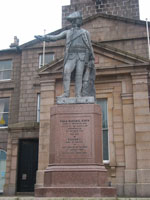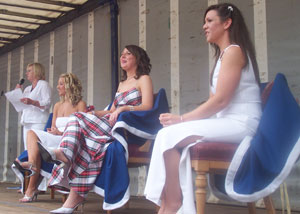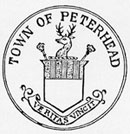TOURISM - EAST OF SCOTLAND |
Back to East of Scotland Page
Peterhead, the most easterly town on the Scottish mainland is situated about 33 miles north-east of Aberdeen . This remote corner of Scotland is not so well known as the Highlands and Islands, but possesses its own unique charm with its towering cliffs, golden beaches, gently rolling countryside, quiet historic villages and surging seas, a quiet corner of the realm where the pace of life is just that much slower. As recent archaeological excavations suggest the town dates back into Pre-historic times. The ancient name of the parish of Peterhead was Peter Ugie (Latin Inverugy Petri) and is found in old charters, formerly to be of much greater extent than at present. |
|
| |
Peterhead was developed from 5th Century pictish settlements at the mouths of River Ugie and Kirkburn. Its name is an abbreviation of 'St Peter's headland', and was taken from a church dedicated to St Peter that was built on the shores of the same bay in the 12th or 13th century. This, and two castles, Ravenscraig and Inverugie, built next to the River Ugie a mile or two north of the church, were the earliest significant settlements in the area. |
Around 1380, Sir John de Keith, owner of Inverugie Castle , founded a fishing village called Keithinch on the most south-easterly point of the headland, and this eventually became known as 'Fishertown of Peterhead'. Small settlements which coalesced until the town was founded around Port Henry harbour in the 16 th century.
Peterhead , as it is known today was founded by George Keith, 5th Earl Marischal following the granting of a charter by James VI creating a burgh of barony and giving a charter allowing a harbour to be built in 1587, in 1593 the burgh was elevated to royal burgh status despite having a population of approximately 200. Apart from a short period as a fashionable 18th-century spa, Peterhead is best known for its fishing heritage: in the 19th century as the chief British whaling centre; herring for most part of the 20th century and in the latter part this gave way in favour of whitefish to supply local fish-processing plants, sadly an industry which has survived centuries is in decline today |
 |
A Celtic church is said to have been established, in the 8th century, near the Kirk Burn where, in 1132, a church dedicated to St Peter was endowed with lands to the sea-ward side of present day Balmoor Terrace. The long ecclesiastical association with St. Peter has said to account for the name of the town but, alternatively, it may have derived from 'Pett-ayr-uisge', meaning the ' Homestead by the water'.
The Buchan coast was inhabited by a clan of Celts known as the Zaizoloi, who were chiefly fisherman supplemented by agriculture and hunting. Living in circles of earth houses, around sheltered bays or shallow estuaries, there are still signs of a community near the Kirkburn on the links.
There are a number of pre-historic cairns and burial chambers in the area as well, one being Cairn Catto which is situated 4 miles SW of Peterhead. |
| |
Peterhead, although being situated in the most easterly part of Scotland and being quite a small coastal town, having in 1593 only a population of 200, which consisted of only 33 families, the typical family being of 6 children, regardless to the size of the town it is certainly steeped in history. Residents to the town were one of the most illustrious families in Scotland , the Keiths. The family, which took its name from the town of Keith in Moray, they were hereditary Great Marischals of Scotland from the 12th Century. The line of the Earl Marischals was created in 1458 by King James II (1430-60) as reward for support against the Black Douglas' . |
| On 29th July 1587, 'Keith Inch alias Peterhead' was erected into a Burgh of Barony in favour of George Keith, 5th Earl Marischal, who, with castles at Dunnottar (near Stonhaven), Inverugie (near Peterhead) and elsewhere, was one of the powerful nobles in the country. Their land-holdings increased still further in the aftermath of the Scottish Reformation. On 1st June 1593 he granted a Feu charter by which feus in the Kirk town and along the line of the Longgate - from the east end of Broad Street to north of Brook lane - were allocated to the original 14 Feu-holders in the town. In 1560, the parish of Peterugie was acquired from the Abbey of Deer by the Keiths Earl Marischals of Scotland , and renamed Peterhead. The fishing village of Keith Inch (Caikinche) situated on an island was presumably also incorporated into Peterhead at about this time. At about this time, the Peterugie settlement was being eroded and people were moving to Almanythie. |
The first reference to the port of Peterhead was by Aberdeen Town Council in 1573 complaining that Peterhead was taking away some of its rightful trade. This may have referred to the harbour at Almanythie Creek, used from prehistoric times. Almanythie (old man's haven) failed to provide safe anchorage during stormy weather. Alternatively, this could have referred to the bays between the headland and the island now called Keith Inch, which did provide a weather shelter except when the gales were from the east.
|
| The Earl Marshall was responsible for quite a lot of the building work in Peterhead including the completion of a 350ft bulwark extension to Port Henry harbour, made of rough undressed granite. The harbour was later used by various military tacticians who considered the harbour to be a good strategic point for landing ships. During the years of the reformation, in 1644 Oliver Cromwell used the port to bring men and supplies onshore, 500 of Cromwell's men were encamped on Keith Inch with their headquarters in the castle. Bubonic plague was rife with some 300 people dying, including many of Cromwell's garrison on Keith Inch. As a result of this, Peterhead's first hospital was built on the most northern part of Ive Park . This consisted of 8 wooden shacks, next to which was the cemetery. Tradition is that a servant of Robert Walker was the first to die at what is now Bruce the Ironmonger in Chapel Street . The plague huts remained in isolation until January 1775. |
James Stuart, the Old Pretender, arrived at Peterhead on December 22, 1715 as part of the '15 Jacobite Uprising. He stayed 6 weeks in Scotland before being persuaded by the Earl of Mar to leave and escape capture. He used Port Henry as a means of landing and departing although it has been said that this was done by mistake due to a storm. But what ever the case might have been he would have certainly known that the Keith's were staunch Jacobite supporters and it would have been safe to land at the port. George's brother James even shared his given name with the Old Pretender, giving evidence of their family's beliefs, although it was George who first threw his lot in with the Jacobites and for their part in the 15 and 19 uprisings they were to be forced into exile. After the battle of Sheriffmuir in 1715 stringent punishments were then being imposed on the supporters of James Edward Stuart. |
|
![The location in the Longgate where the James Stuart [ The Old Pretender ] stayerd after he landed at Peterhead before travelling south in 1715.](tour/Peterhead-192.jpg) |
The justice dealt by the Hanoverians was swift and brutal. Lands of sympathisers were confiscated and lives lost. The brothers had no choice but to follow the lead of their 'King' in flight. In March 1716 they sailed to the Western Isles to begin their journey into exile - an exile which for James was strangely glorious. On the day he set sail from Uist, destined for France , the Keith family were being stripped of their rank, honours, lands and properties, up until this point the Keiths were superiors of the town . At this time, many members of the Keith Clan also fled to Ireland and America . For James Francis Edward Keith who was born at Inverugie his life was to change, he was to become better known for his services as a military commander under Frederick II of Prussia . |
| Their estates were confiscated and sold to the York Buildings Company, but when it became bankrupt, the Governors of the Merchant Maiden Hospital in Edinburgh purchased the town and harbours of Peterhead in 1728; the Edinburgh Merchant Company has retained the Superiority of the town ever since. With the Keith family having their estate confiscated, the Keith brothers remained in Europe , James followed his Jacobite flutterings and served for a time in the Spanish army and in Russia (1728), they distinguished himself in the War of the Polish Succession and in campaigns against the Ottoman Turks and Sweden . He entered the Prussian service in 1747 where James was made a field marshal by Frederick the Great. During the Seven Years' War, he commanded Prussian forces at the siege of Prague (1757) and successfully defended Leipzig against the Austrians. Eventually James was killed in the Battle of Hochkirch on October 14th 1758 . James and George Keith became highly respected in Europe and although George eventually returned to Scotland and was able to reclaim some of his old family properties. He was to eventually die in Berlin in 1778 leaving as his heir on whom the head of the Keith family and the title of Earl of Kintore descended – Anthony 8th Lord Falconer. In 1868 a monument donated by William I of Prussia was erected to Keith's memory in the Broadgate of Peterhead. As far as the Old Pretender being in Peterhead there is not much in the town today to remind us that he was ever there, there is a small plaque hidden away in a close, but perhaps the best reminder is a street named after the Stuart family “Greater Stuart Street”. In the museum there was a copy of a letter from the Old Chevalier dated 22/12/1715 , thanking his friends in Peterhead for their assistance. During the 1719 uprising Spanish Armada cannons were mounted on the Tollbooth green, the cannons can still be seen in Peterhead today. |
Other well known associates with Peterhead include
Rev. James Keith 1696 - 1753 was born in Peterhead but because of his Jacobite sympathies he emigrated to Virginia and married Mary Isham Randolph who was a direct descendant of Pocahontas. Other famous names associated with this family were Robert E Lee and Thomas Jefferson. Peterhead certainly has its share of being associated with famous names
The Arbuthnot family of the Peterhead area came from the Mearns in the mid-sixteenth century. As landowners and merchants they were an important family locally. Notable members included John Arbuthnot (d 1735), Physician to Queen Anne; Charles Arbuthnot (1739-1820), last Lord Abbot of Ratisbon; George Arbuthnot (1775-1847), 1st Provost of Peterhead 1833-34; and Thomas Arbuthnot (b 1792), 2nd Provost of Peterhead 1834-43.
Thomas Arbuthnot (1681-1762), the 'Old Bailie', was Baron Bailie of Peterhead to the 10th and last Earl Marischal. The Old Bailie's son, Thomas (1727-1773), was a Lieutenant at Culloden in the Jacobite army. Adam Arbuthnott (1773-1850), son of the younger Thomas, was the founder of the Arbuthnot Museum (Arbuthnot, 1920).
Retiring from merchant business about 1820, Adam Arbuthnot devoted his leisure to the acquisition of a collection of antiquities, coins and objects in natural history. By 1837 his museum had become well known locally and the writer of the 'New Statistical Account' of Peterhead commented that 'the museum is not always accessible to the public' (Donald, 1845). When Adam Arbuthnot died in 1850, he bequeathed his collections to the Provost, Magistrates and Town Council of Peterhead.
1585 The historic Ugie Salmon fishhouse at the mouth of the Ugie was built by the 4th Earl Marischal. This 400 year old salmon house is the oldest surviving building in Peterhead. It is also the oldest working premises in Scotland . “The Fish House” was built on the banks of the River Ugie in 1585 for George Keith, 5 th Earl Marischal, for keeping game and fish. Still standing, it has been used by salmon fishermen for over 100 years, and is now owned by Ugie Salmon Fishing's who "have mastered to perfection the arts of catching, preparing and smoking Scottish Salmon. The closely guarded skills and knowledge of our forefathers have been handed down from generation to generation
1818 saw the start of the building of the North Harbour after designs by Thomas Telford, who also did the Caledonian canal and the bridge over the Menai Straits .
1827 The Lighthouse at nearby Boddam was built by Robert Stevenson. Robert Stevenson was the grandfather of Robert Louis Stevenson, better known for writing classics such as Treasure Island , Dr Jekyll and Mr Hyde, and Kidnapped.
. 1888 Peterhead prison was opened Scotland 's first and only convict prison. Until the opening of the prison, Scots convicts were transported to England to serve their sentences. The prison was served by a unique railway line, the only state owned passenger carrying railway in its day, unfortunately this no longer exists, today the old rail line is used by walkers who can follow the route all the way to Aberdeen . Initial excavations around the prison unearthed interesting findings for Granite was not the first stone to be quarried in this area. Just a few hundred metres away from Stirling Hill was the then undiscovered site of a vast flint working which men of the Neolithic age, some 4000 years ago, had worked for as long as 300 years, bringing forth flint which, until recent years, had been thought to have been imported to Scotland from England and Ireland, the deposit being unique in Scotland, there being no other land deposits of flint in the country.
That detail would have been very unlikely to have held any interest for the convicts who were to take stone from the Stirling Hill site, nor as they laboured to smash granite (with their choice of seven or fourteen pound hammers) would they have been grateful for the information that the stone which sent jarring vibrations up their arms to ache their muscles with every strike, had started existence as a molten layer 5 kilometres below the surface, some 407-11 million years ago.
An igneous rock, granite is one of the best wearing rocks man uses for major works. It blunts the hardest tempered steel chisels, so when shaped it will resist the ravages of climate and vandalism, remaining intact for many thousands of years. The stone of which Aberdeen is built.
|
| In this case, the stone from Stirling Hill was used to build a prison to contain the convicts of Scotland (many of them the most dangerous of criminals) and to build a barrier against the might of the North Sea , a harsh and unrelenting enemy, the power of which was to be thwarted by the Peterhead breakwater. That breakwater created a harbour of refuge for the ships of the North Sea (known as the German Sea when work began) and will serve as such long after its builders and this present generation of Peterhead residents are gone. When the breakwater was conceived, the cost of the undertaking was estimated at £750,000 it being anticipated that the work would be completed in 25 years. From the arrival of the first convict it was to be over 70 years before the last granite block was laid in the roundel of the north breakwater. |
|
From 1888 the harbour facilities were greatly improved with the building of a series of huge breakwaters, the largest 900m in length, to create a vast "harbour of refuge" encompassing the whole of Peterhead Bay. The boom and bust in the whaling industry was mirrored in the herring fishery. At the peak of the herring boom in 1890, Peterhead's fleet numbered some 580 vessels. When the herring stocks began to dwindle, the fleet turned its attention to white fish and after the First World War several trains left the town each day carrying fish to southern markets. By 1987 Peterhead was Europe's largest white fish port, with over 400 boats landing nearly 120,000 tonnes at Europe's biggest fish market, measuring nearly 400m from end to end. Over the past years external economic circumstances have brought questions of confidence and image into sharp focus. The crisis in the fishing industry, downsizing of RAF Buchan and threats to Peterhead Prison have dented business confidence and brought insecurity to the community which seems quite ironic particularly because of the oil revenues sustained since the 1970's and Peterhead being an important base for serving the oil industry, but Peterhead still has a lot to offer.
|
| A wealth of Peterhead's maritime history in one of Aberdeenshire's oldest museums the Arburthnot Museum a building which first opened it's doors in 1834 and also includes one of the north easts largest coin collections. |
A Farmers Market is held regularly in Drummers Corner, where you can purchase fresh vegetables, fruit, meat and fish. On occasional Saturdays within the town centre you will find a variety of street entertainers. Drummer's Corner is named after the former army drummer James Milner. Mr Milner went on to have a shop on the town corner and also acted as the town's drummer, hence "Drummer's Corner".
A popular bird watching location, especially for puffins, is at the Bullars O' Buchan, some 5 miles to the south of the town. |
| Peterhead Bay provides the ideal location for those interested in participating in water sports; sailing, kayaking, jet skiing and adequate berthig facility at the 100 berth leisure marina and for those who want to stay on dry land there is a variety of paths and cycle ways in and around the town. To the North is the important RSPB Reserve, Loch of Strathbeg. There are also numerous castles and cairns in the area. |
|
| During the summer you will also see a variety of cruise ships in the Bay. German and American cruise liners were in port last year, each carrying up to 800 passengers. |
 |
Peterhead Scottish Week, which runs from 15th - 23rd July, is the only event of its kind left in Scotland , and has been running since 1961. |
|
 |
It provides a week of activities in which the whole community participates –Pipebands, highland dancing, ceilidh music, Junior Pop Idol, raft race, exhibition events, dog show, parades and a motor vehicle show. In the build up to Scottish Week, the Buchan Queen and Princesses are chosen, selected from local young girls who enter the competition. A local celebrity who also performs the opening ceremony and crowns them at the opening event on the Saturday. The objectives of Peterhead Scottish week have changed over the years. When it was initially set up in 1961 it was to promote Scottish produce. Originally there were several Scottish weeks all over Scotland . Peterhead now boasts the last surviving Scottish week. More recently Peterhead Scottish week has been the focus of tourism and entertainment for one whole week in July. |
| Peterhead is in a part of North-East Scotland called Buchan where the language tends to be different from any other that you may of heard in Scotland a lot of the words come from the Doric a language known to the North-East, below is a sample of some of the words and dialect used today. |
Adee |
Derived from ado, meaning wrong. "Fit's adee?" - what's wrong? |
Affa |
Very, terribly. For example, "an affa fine loon" - a very nice lad, "ging at an affa lick" - going terribly fast. |
Ay-ay |
A simple greeting, similar to good-day, how are you? |
Barkit |
"Yer cleethes are barkit" - meaning excessively dirty |
Bosie |
A hug, or embrace deriv bosom |
Brikks |
Trousers (or troosers, as many would believe, after the song 'Donald, where's yer ..." |
Chavvin awa |
Struggling along ) normally as a response to the interrogative, "fit like?" |
Chuddie |
Chewing gum. |
Drucht |
Breeze - a "fine drucht" would be a good (clothes) drying breeze, or more likely for this area, a Force 12 draught) |
Forfochen |
Exhausted |
|
|
Ganzie |
Jumper |
Gey Grippy |
Mean,watches the pennies |
Gyad |
Yuk |
Lugs |
Ears |
Lum |
Chimney |
Nickum |
Mischievous, rather than bad |
Nippet |
Tight "His troosers are gey nippet" |
Nivir |
Never |
Nyaff |
A small or worthless person or thing |
Pints |
Laces |
Queets |
Ankles |
Quine |
Girl |
Rigget oot |
Dressed |
Sair chaave |
Hard going |
Waldies |
Wellingtons |
Yokin time |
Starting time |
Yon |
That |
|
Back to Top
|



![The location in the Longgate where the James Stuart [ The Old Pretender ] stayerd after he landed at Peterhead before travelling south in 1715.](tour/Peterhead-192.jpg)



